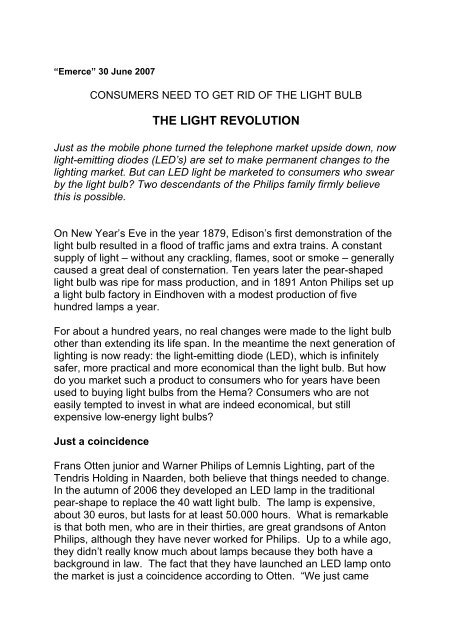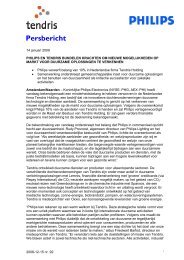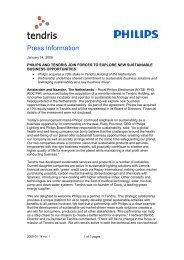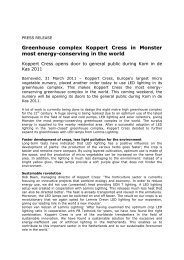the light revolution - Lemnis Lighting
the light revolution - Lemnis Lighting
the light revolution - Lemnis Lighting
You also want an ePaper? Increase the reach of your titles
YUMPU automatically turns print PDFs into web optimized ePapers that Google loves.
“Emerce” 30 June 2007CONSUMERS NEED TO GET RID OF THE LIGHT BULBTHE LIGHT REVOLUTIONJust as <strong>the</strong> mobile phone turned <strong>the</strong> telephone market upside down, now<strong>light</strong>-emitting diodes (LED’s) are set to make permanent changes to <strong>the</strong><strong>light</strong>ing market. But can LED <strong>light</strong> be marketed to consumers who swearby <strong>the</strong> <strong>light</strong> bulb? Two descendants of <strong>the</strong> Philips family firmly believethis is possible.On New Year’s Eve in <strong>the</strong> year 1879, Edison’s first demonstration of <strong>the</strong><strong>light</strong> bulb resulted in a flood of traffic jams and extra trains. A constantsupply of <strong>light</strong> – without any crackling, flames, soot or smoke – generallycaused a great deal of consternation. Ten years later <strong>the</strong> pear-shaped<strong>light</strong> bulb was ripe for mass production, and in 1891 Anton Philips set upa <strong>light</strong> bulb factory in Eindhoven with a modest production of fivehundred lamps a year.For about a hundred years, no real changes were made to <strong>the</strong> <strong>light</strong> bulbo<strong>the</strong>r than extending its life span. In <strong>the</strong> meantime <strong>the</strong> next generation of<strong>light</strong>ing is now ready: <strong>the</strong> <strong>light</strong>-emitting diode (LED), which is infinitelysafer, more practical and more economical than <strong>the</strong> <strong>light</strong> bulb. But howdo you market such a product to consumers who for years have beenused to buying <strong>light</strong> bulbs from <strong>the</strong> Hema? Consumers who are noteasily tempted to invest in what are indeed economical, but stillexpensive low-energy <strong>light</strong> bulbs?Just a coincidenceFrans Otten junior and Warner Philips of <strong>Lemnis</strong> <strong>Lighting</strong>, part of <strong>the</strong>Tendris Holding in Naarden, both believe that things needed to change.In <strong>the</strong> autumn of 2006 <strong>the</strong>y developed an LED lamp in <strong>the</strong> traditionalpear-shape to replace <strong>the</strong> 40 watt <strong>light</strong> bulb. The lamp is expensive,about 30 euros, but lasts for at least 50.000 hours. What is remarkableis that both men, who are in <strong>the</strong>ir thirties, are great grandsons of AntonPhilips, although <strong>the</strong>y have never worked for Philips. Up to a while ago,<strong>the</strong>y didn’t really know much about lamps because <strong>the</strong>y both have abackground in law. The fact that <strong>the</strong>y have launched an LED lamp onto<strong>the</strong> market is just a coincidence according to Otten. “We just came
across it. My first reaction was: surely it isn’t possible for a privateindividual inventor to come up with such a fantastic product”. But100,000 Pharox lamps have already been produced and Tendris isplanning to use <strong>the</strong>m to conquer <strong>the</strong> consumer market.The company has entered into a cooperation agreement with Princess,<strong>the</strong> manufacturer of small domestic appliances, but Otten has alsoalready flown a couple of times to India and China. “Light bulbsrepresent about 20 percent of worldwide energy consumption” he says.“If you want to reduce this, you need to be in countries where energy isalready a scarce commodity”. In this way Otten is more or less followingin <strong>the</strong> footsteps of his great-grandfa<strong>the</strong>r, who dragged a suitcase full of<strong>light</strong> bulbs to what was <strong>the</strong>n <strong>the</strong> Russian Empire. “When <strong>the</strong> <strong>light</strong>ingmarket exploded a hundred years ago, dozens of factories in Europestarted competing against each o<strong>the</strong>r and <strong>the</strong> future of Philips becameuncertain. At <strong>the</strong> time Anton thought: if I can get those crazy Russians tobuy my lamps, <strong>the</strong>n I can be sure of sales and that will give me acompetitive margin in Europe. That is what made Philips great.”The market lies openSo great in fact, that Philips has dominated <strong>the</strong> <strong>light</strong> bulb market formany years, along with General Electric and Siemens-subsidiary Osram.Hovering around <strong>the</strong>m are also manufacturers of <strong>light</strong> fittings andspecialized <strong>light</strong>ing applications. With <strong>the</strong> arrival of LED <strong>the</strong> market onceagain lies completely open, according to Frans Otten. “Of course Philipsand o<strong>the</strong>r manufacturers are busy developing LED <strong>light</strong>ing, but <strong>the</strong>y aresaddled with a legacy that is difficult for <strong>the</strong>m to ignore: <strong>the</strong> many yearsof investment in low-energy <strong>light</strong> bulbs for which <strong>the</strong> costs gradually needto be recovered – and <strong>the</strong>refore you don’t immediately launch areplacement onto <strong>the</strong> market.”However, Frank van der Vloed, Director of Philips <strong>Lighting</strong> TheNe<strong>the</strong>rlands, assures us that it isn’t that simple. “We too believe thatsome time in <strong>the</strong> future <strong>the</strong> LED lamp will replace <strong>the</strong> <strong>light</strong> bulb, but at<strong>the</strong> moment LED is not yet a fully-fledged candidate for <strong>the</strong> replacementof <strong>the</strong> consumer low-energy <strong>light</strong> bulb or for strip <strong>light</strong>ing. An LED lampsaves less energy than <strong>the</strong> low-energy <strong>light</strong> bulb, is six or seven times asexpensive, and <strong>the</strong> shade of <strong>light</strong> it gives is considered to be cool. It ispossible to do something about <strong>the</strong> latter but this will <strong>the</strong>n affect <strong>the</strong>brightness. The lumens per watt first need to be increased in order tooptimize <strong>the</strong> colour balance.” And Philips is not prepared to sell LED toconsumers based only on a longer life-span.
The LED is however already suitable for a number of applications, inparticular high-powered LED applications. Van der Vloed: “We <strong>light</strong> upBuckingham Palace with LED <strong>light</strong>ing. At one time <strong>the</strong> British Queenwasn’t in favour of <strong>light</strong>ing up <strong>the</strong> Palace because normal <strong>light</strong>ing wastoo bright, but with LED it is acceptable”. Ano<strong>the</strong>r application is office<strong>light</strong>ing in places where replacing <strong>light</strong> bulbs is costly. But on <strong>the</strong>consumer market Philips would ra<strong>the</strong>r carry out a multi-track policy: forinstance, later this year <strong>the</strong> low-energy <strong>light</strong> bulb will receive competitionfrom a new halogen lamp that is fifty percent more economical than <strong>the</strong>traditional <strong>light</strong> bulb. “We don’t prefer a particular technique – we arecompletely neutral” says Van der Vloed. “The one is not per definitionbetter than <strong>the</strong> o<strong>the</strong>r, it depends on <strong>the</strong> application”. However, leadingmanufacturers are about to proclaim a production stop for pear-shaped<strong>light</strong> bulbs and in December, Philips announced that <strong>the</strong>y were going tophase-out <strong>the</strong>ir production of traditional <strong>light</strong> bulbs. “An important stepfor a manufacturer that makes more conventional <strong>light</strong> bulbs than lowenergy<strong>light</strong> bulbs” stresses Van der Vloed. “And rightly so” adds FransOtten “<strong>the</strong> conventional <strong>light</strong> bulb is more or less an outdated solutionanyway”.The manufacturers are not alone in taking this view. The AustralianPrime Minister John Howard wants only low-energy <strong>light</strong> bulbs to beused in his country by <strong>the</strong> year 2010. In California, Germany andBelgium <strong>the</strong>re are also plans to implement a ban and <strong>the</strong> EuropeanCommission would like to be rid of <strong>the</strong> traditional <strong>light</strong> bulb by 2009. Inour country <strong>the</strong> majority of <strong>the</strong> Second Chamber would like legalmeasures to be taken in order to make low-energy lamps cheaper. Thisis necessary because according to <strong>the</strong> trade, <strong>the</strong> demand for low-energylamps is something like three percent, which is minimal. That is lessthan a couple of years ago when all sorts of low-energy lamp promotionswere initiated. This is <strong>the</strong> reason that Philips is working with Greenpeaceto provide <strong>the</strong> whole of Schiermonnikoog with free low-energy lamps.However, according to Otten it doesn’t make sense to force consumersto buy lamps “that <strong>the</strong>y didn’t want anyway”. Fur<strong>the</strong>rmore, <strong>the</strong> low-energylamp has to be disposed of as chemical waste, gives off similar <strong>light</strong> tostrip <strong>light</strong>ing, and can’t be dimmed.But at Philips <strong>the</strong>y consider this argument to lack foundation. Manydrawbacks of <strong>the</strong> low-energy lamp – <strong>the</strong> cool <strong>light</strong>, <strong>the</strong> high price and <strong>the</strong>irritating flicker – have been removed as a result of technicaldevelopments. Just like <strong>the</strong> misunderstanding that a low-energy lamp istoo big for existing fittings. On <strong>the</strong> o<strong>the</strong>r hand, <strong>the</strong> technical development
of LED is also advancing: for instance, Osram has already come up with<strong>the</strong> first LED with 1000 lumens, more <strong>light</strong> than is given off by atraditional 50 watt <strong>light</strong> bulb; and it is expected that an LED lamp will bedeveloped to replace a 70 watt <strong>light</strong> bulb before <strong>the</strong> end of this year.Theo van Deursen, Managing Director of Philips <strong>Lighting</strong>, also expects arise of 25-30% per year in <strong>the</strong> sale of LED <strong>light</strong>ing. And Cees Bruines,Director of Osram Benelux would not be surprised if <strong>the</strong> turnover of LEDlamps increases in <strong>the</strong> future by a factor of 2,5. Philips in particular isconsiderably streng<strong>the</strong>ning its investment in LED <strong>light</strong>ing. In 2005, <strong>the</strong>concern became <strong>the</strong> new owner of Lumileds, a company that makesLED lamps for street <strong>light</strong>ing and for <strong>light</strong>ing up buildings. And in March,Philips also took over <strong>the</strong> Canadian company TIR Systems which alsospecializes in low-energy <strong>light</strong>ing technology for <strong>the</strong> business market.Consumer marketBut <strong>the</strong> biggest challenge will be <strong>the</strong> consumer market. Because LEDlamps are much smaller than traditional lamps, this technology offersnew possibilities for <strong>the</strong> design of fittings and is <strong>the</strong> reason why Philipshas taken over PLI, one of <strong>the</strong> biggest <strong>light</strong> fitting manufacturers (withbrand names such as Massive, TRIO and Lirio). “In <strong>the</strong> future we will nolonger be selling <strong>light</strong>s, but <strong>light</strong>ing solutions” emphasizes Van der Vloed.An important aspect of <strong>the</strong> marketing strategy of <strong>the</strong> two entrepreneursfrom Eindhoven is <strong>the</strong> ‘fun’ element. One example of a new productintroduced onto <strong>the</strong> market by Philips is <strong>the</strong> Living Colours lamp whichhas four LED’s: two red, one green and one blue. With <strong>the</strong> help of aremote control, <strong>the</strong>se can be combined to make 16 million differentcolours. LED lamps are also ideal for use as artificial candle<strong>light</strong> whichlooks deceptively like genuine candle<strong>light</strong>. There are also new lamps(SpotOn) that have movement sensors which automatically switch onand off as you walk past. In addition, Philips has set up a specialdivision for Photonic Textiles, from which <strong>the</strong> first products are expectedin mid-2007. With Lumalive-textiles it is possible, among o<strong>the</strong>r things, toprovide materials with dynamic texts, images, and surfaces on which<strong>the</strong>re is a constant change of colour. In this way fabrics, cushions andgrand-foulards can be brought to life when <strong>the</strong>y are lit up.And that isn’t all. Within five years, <strong>the</strong> classy shops in <strong>the</strong> PCHooftstraat in Amsterdam will be fitted out with Philips’ newesttechnological <strong>light</strong>ing features. Interactive shop-window screens willautomatically show things like clothing collections to passing shoppers,
clo<strong>the</strong>s racks will turn red when red shirts are hung onto <strong>the</strong>m and shoeswill <strong>light</strong> up when people walk pass <strong>the</strong>m. The main Philips showpiece is<strong>the</strong> interactive shop-window. A sensor reacts when a passer-by stops tolook at <strong>the</strong> articles in <strong>the</strong> window. These articles can <strong>the</strong>n be spot<strong>light</strong>edwhile extra information is also given on a small screen.• Frank van der Vloed has been working in <strong>the</strong> <strong>light</strong>ing business fortwenty years and thinks that this is just <strong>the</strong> start of some importantyears for Philips. “You really notice that <strong>the</strong> company nowconsiders <strong>light</strong>ing to be important once again and that it can makea contribution to profits. A great deal of investment is taking place.”And according to Van der Vloed, <strong>the</strong> fact that <strong>the</strong>re are newcompetitors on <strong>the</strong> market only makes it more exciting. Even nowthat <strong>Lemnis</strong> has taken on ex-Philips man Tim Cremer as Director.“Logical, don’t you think?”, says Frans Otten with a meaningfulsmile.Facts about <strong>light</strong>ing:• About two-thirds of all <strong>light</strong>ing in <strong>the</strong> European Union is based on old technology.• 20 percent savings on <strong>light</strong>ing energy is equal to ei<strong>the</strong>r 779 million barrels of oil or<strong>the</strong> annual production of 265 power stations.• Toge<strong>the</strong>r all Dutch local councils can save 1.7 billion euros by replacing old street<strong>light</strong>ing.Photo caption:‘In <strong>the</strong> future, Philips will no longer be selling <strong>light</strong>s, but<strong>light</strong>ing solutions’The European Commission wants to be rid of <strong>the</strong>traditional <strong>light</strong> bulb by 2009






